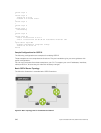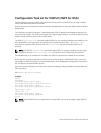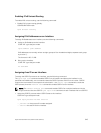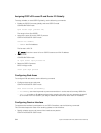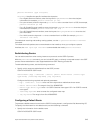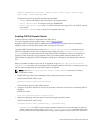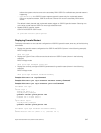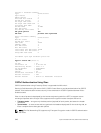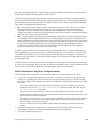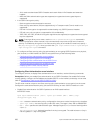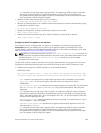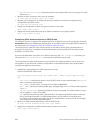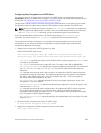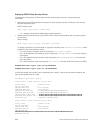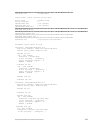
Process 1 database summary
Type Count/Status
Oper Status 1
Admin Status 1
Area Bdr Rtr Status 0
AS Bdr Rtr Status 1
AS Scope LSA Count 0
AS Scope LSA Cksum sum 0
Originate New LSAS 73
Rx New LSAS 114085
Ext LSA Count 0
Rte Max Eq Cost Paths 5
GR grace-period 180
GR mode planned and unplanned
Area 0 database summary
Type Count/Status
Brd Rtr Count 2
AS Bdr Rtr Count 2
LSA count 12010
Summary LSAs 1
Rtr LSA Count 4
Net LSA Count 3
Inter Area Pfx LSA Count 12000
Inter Area Rtr LSA Count 0
Group Mem LSA Count 0
Dell#show ipv6 ospf database grace-lsa
!
Type-11 Grace LSA (Area 0)
LS Age : 10
Link State ID : 6.16.192.66
Advertising Router : 100.1.1.1
LS Seq Number : 0x80000001
Checksum : 0x1DF1
Length : 36
Associated Interface : Gi 5/3
Restart Interval : 180
Restart Reason : Switch to Redundant Processor
OSPFv3 Authentication Using IPsec
OSPFv3 authentication using IP security (IPsec) is supported the MXL switch.
Starting in Dell Networking OS version 8.4.2.0, OSPFv3 uses IPsec to provide authentication for OSPFv3
packets. IPsec authentication ensures security in the transmission of OSPFv3 packets between IPsec-
enabled routers.
IPsec is a set of protocols developed by the internet engineering task force (IETF) to support secure
exchange of packets at the IP layer. IPsec supports two encryption modes: transport and tunnel.
• Transport mode — encrypts only the data portion (payload) of each packet, but leaves the header
untouched.
• Tunnel mode — is more secure and encrypts both the header and payload. On the receiving side, an
IPsec-compliant device decrypts each packet.
NOTE: The Dell Networking OS supports only Transport Encryption mode in OSPFv3 authentication
with IPsec.
648
Open Shortest Path First (OSPFv2 and OSPFv3)



